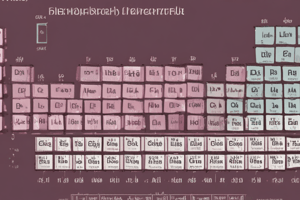Podcast
Questions and Answers
What is a period of elements on the periodic table?
What is a period of elements on the periodic table?
A period of elements on the periodic table is a horizontal row in which all the elements in that row have valence electrons in the same energy level.
What is a group of elements on the periodic table?
What is a group of elements on the periodic table?
A group of elements is a vertical column on the periodic table in which all the elements have the same number of valence electrons.
What is a cation?
What is a cation?
A cation is a positive ion.
Which is larger, a cation or its corresponding atom? Why?
Which is larger, a cation or its corresponding atom? Why?
What is an anion?
What is an anion?
Which is larger, an anion or its corresponding atom? Why?
Which is larger, an anion or its corresponding atom? Why?
How do the atomic radii vary within a period on the periodic table? Why?
How do the atomic radii vary within a period on the periodic table? Why?
How do the atomic radii vary within a group on the periodic table? Why?
How do the atomic radii vary within a group on the periodic table? Why?
What is ionization energy?
What is ionization energy?
How does ionization energy vary within a group on the periodic table? Why?
How does ionization energy vary within a group on the periodic table? Why?
How does ionization energy vary within a period on the periodic table? Why?
How does ionization energy vary within a period on the periodic table? Why?
What is electronegativity?
What is electronegativity?
How does electronegativity vary within a group on the periodic table? Why?
How does electronegativity vary within a group on the periodic table? Why?
How does electronegativity vary within a period on the periodic table? Why?
How does electronegativity vary within a period on the periodic table? Why?
Which group of elements would have the highest ionization energy? Why?
Which group of elements would have the highest ionization energy? Why?
Who is given credit for developing the modern day Periodic Table of Elements?
Who is given credit for developing the modern day Periodic Table of Elements?
Know where the alkali metal, alkali earth metals, halogens, and noble gases are located on the Periodic Table.
Know where the alkali metal, alkali earth metals, halogens, and noble gases are located on the Periodic Table.
How is the modern day Periodic Table different than Mendeleev's?
How is the modern day Periodic Table different than Mendeleev's?
Flashcards are hidden until you start studying
Study Notes
Periodic Table Concepts
- Periods are horizontal rows where elements share the same energy level for valence electrons.
- Groups are vertical columns with elements that have the same number of valence electrons.
Ions
- Cations are positive ions formed when an atom loses electrons, resulting in a smaller size than the original atom.
- Anions are negative ions formed when an atom gains electrons, leading to a larger size than the original atom.
Atomic Radii Trends
- Within a period, atomic radii decrease due to increased positive attraction from the nucleus as atomic number increases.
- Within a group, atomic radii increase as atomic number rises because of added electron shells creating a shielding effect.
Ionization Energy
- Ionization energy is the energy required to remove an electron from an atom.
- In groups, ionization energy decreases with increasing atomic number due to the greater shielding effect that weakens the attraction to outer electrons.
- In periods, ionization energy increases with atomic number because outer electrons are held more tightly due to stronger nuclear attraction.
Electronegativity
- Electronegativity measures an atom's ability to attract shared electrons, ranging from 0.0 to 4.0.
- Electronegativity decreases in groups as atomic number increases due to increased shielding, making outer electrons less tightly held.
- Electronegativity increases in periods as atomic number increases because elements approach a stable octet configuration.
Group Characteristics
- Noble gases (Group 18) possess the highest ionization energy due to their stable octet, making them reluctant to lose electrons.
- Alkali metals are located in Group 1, alkaline earth metals in Group 2, halogens in Group 17, and noble gases in Group 18.
Historical Context
- Dmitri Mendeleev is credited with creating the modern Periodic Table.
- The modern Periodic Table differs from Mendeleev's original by including noble gases, organizing elements by atomic number rather than atomic weight, and arranging families vertically instead of horizontally.
Studying That Suits You
Use AI to generate personalized quizzes and flashcards to suit your learning preferences.




